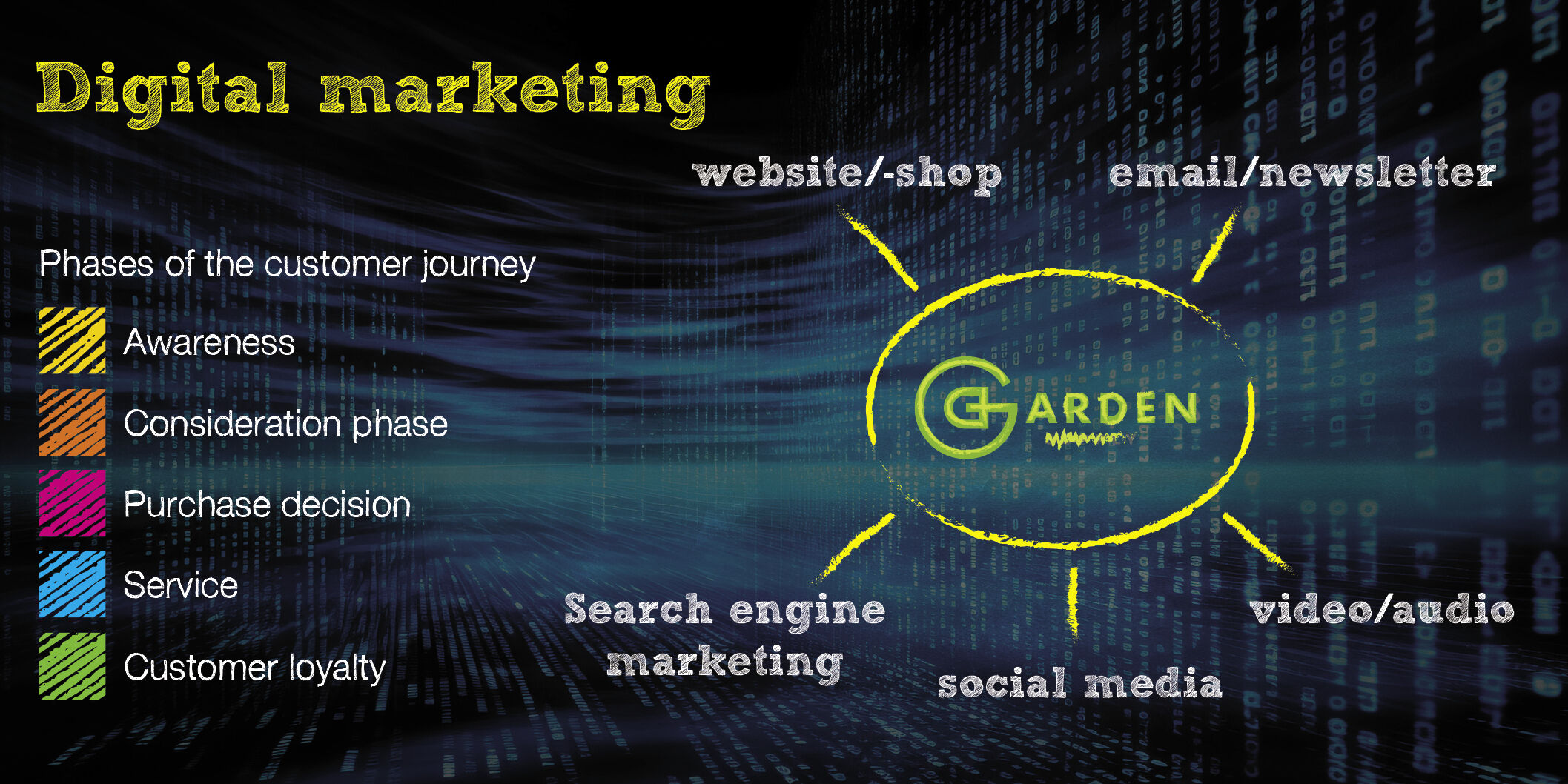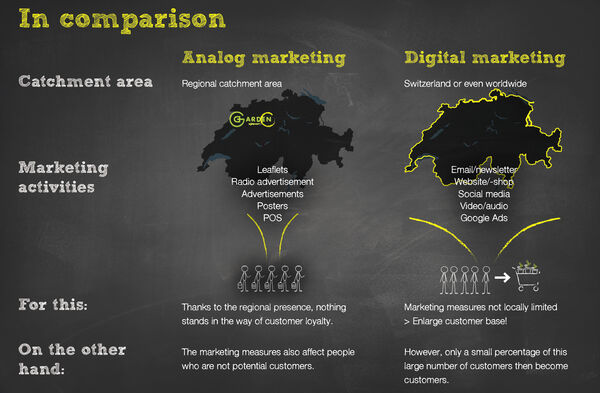
In addition, figures such as reach, clicks, views and followers need to be put into perspective. What sounds like a lot at first glance is not that high in reality or in comparison to analogue advertising media. Or to put it another way: on average, much more digital interaction is required to turn a prospective customer into a customer.
In order to use digital marketing measures successfully, you need to understand how they work and what the basic mechanism behind them is. Then you can also better assess whether these forms of advertising are suitable for your own company. In this part of our marketing series, we present the most important digital marketing options.
Website – the central marketing tool
Nowadays, the website is the linchpin of all marketing and advertising activities. The website is ideal for displaying both digital and analogue content. Thanks to PDFs and images, all analogue content can also be made available digitally.
In the classic sense, a website can be imagined as a person at the reception desk, with the great advantages that it can provide information to many people at the same time, is available around the clock and is very cost-effective. To be able to provide good information, the website must of course contain what potential customers want to know about your company.
A website simply belongs to every company, no matter how small it is. As soon as a company provides services for others, it should be found on the Internet via a website. The website should contain at least the most important information: Who is behind the company, what it offers, where it is located and how to get in touch. It is like an entry in the telephone directory or in previous business directories. A one-page website may be completely sufficient for this purpose.
For larger companies, a more comprehensive web presence is a must. A good website is the digital business card and yet it is astonishing how often this opportunity is underutilised. The following principles should be observed:
- Less is more. Short, concise and relevant information is better than long, meaningless texts.
- The content must be up to date. Information that has not been valid for several weeks is not a sign of professionalism. The same applies to spring offers that are still displayed in autumn. It is worth timing the content here.
- Good images, simple navigation and an organised presentation of content are important.
- Responsive is a must and the website should also be state of the art in other respects.
Unfortunately, it is always shocking to see how inadequately the opportunities of a good Internet presentation are utilised. A simple website can be realised relatively inexpensively today and is a good investment. Or in a figurative sense: the person at reception doesn't have to wear a tailor-made suit, but neither does he or she have to wear an old, worn-out T-shirt.

Webshop – the shop window
It's hard to make big money with an online shop in the green sector, not least because many items are difficult to ship. Two factors in particular are decisive for the success of an online shop: the software and the logistics. If a company has both under control, the offers are often of secondary importance. A third point is price and comparability.
Nevertheless, there are also good reasons for smaller companies to have a simple online shop. The software of online shops is usually designed in such a way that large, structured data volumes can be managed and displayed relatively easily. This means that the company can use an online shop as a showcase for its products and thus demonstrate the breadth of its range, for example by advertising exclusive specimen plants. The fact that customers can collect larger items and plants ordered from the web shop on site has proved very successful in the green sector.
Online offers for flower orders can also be successful. If a customer wants to give flowers as a gift, they usually look for a florist near the recipient. The potential of gift vouchers in the webshop should not be underestimated; they can be sent easily. Another possible application is, for example, registration or booking for courses, events, etc.
None of these applications require an extremely expensive software solution, but they certainly do require a payment connection. Twint, for example, has become a very popular online payment method and can be integrated relatively cheaply. Every online shop operator needs to be aware of this: Most online shoppers have high expectations in terms of speed of delivery, price and ease of use.
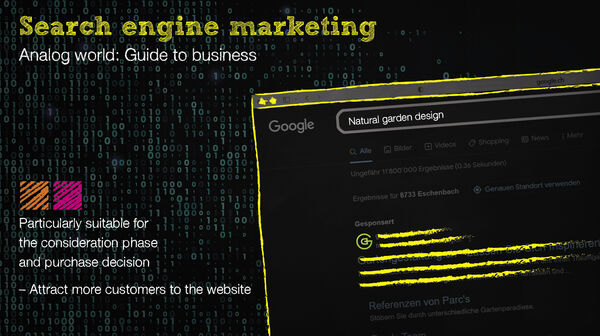
The Google universe
Why do people only ever talk about Google when there are numerous alternatives? Because Google accounts for over 90% of search queries. Google offers various options to attract more visitors to your website – free of charge or for a fee.
One of these is a free company listing (which requires a free Google account). In addition to basic company data, offers and products can also be placed. This good form of advertising is often underutilised. This is because when someone specifically searches for a company, the entry is displayed very prominently in the search results.
The Google search engine still has the greatest reach. The aim of website operators is to be at the top of the relevant search terms. How this is achieved is relatively complicated, as a complex algorithm with countless criteria decides which website is most relevant for which search term. The more general a search term is (e.g. horticulture), the more offers and information there will be about it. For a good positioning in the Google search, it is therefore helpful if relevant content on this search term is available on the website – e.g. in the form of blog posts.
The paid options include the option of displaying text adverts (Google ADS) for certain keywords in the search results. How well you are positioned there depends on how much you are prepared to pay for this click and how high your competitors' bids are.
Another form of paid advertising is display ADS. These are advertising banners that are displayed on partner websites of Google and on YouTube. They are an interesting way to advertise events and promotions.
There are basically two different billing systems for display advertising: you pay per advert or per click. The per-click option is almost always preferable, even if the offers per advert sometimes sound very lucrative. For example, 100,000 impressions are promised. In most cases, however, these are used up very quickly and the click rate is usually less than 1%. In addition, the impressions themselves are generally difficult to measure. With payment per click, it is possible to measure how many visitors have actually reached the website.
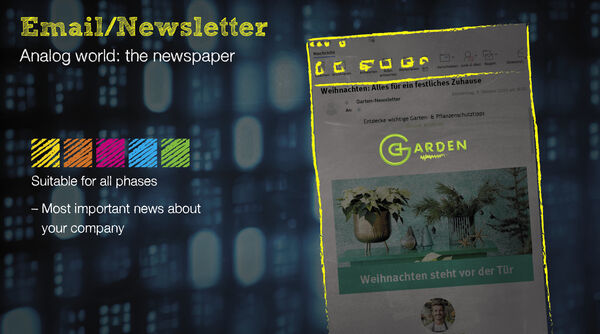
Newsletter – a door opener
Newsletters are an inexpensive and still very effective form of digital advertising. Of course, you might ask yourself who still reads newsletters in this flood of emails, but experience shows that good and relevant content is still in demand and is read. What is important with a newsletter is a certain regularity. This depends on how much you have to communicate. And this in turn has a direct influence on whether the newsletter is read.
A good newsletter has the same layout as the website and other advertising material. In addition, the information should primarily arouse interest and then lead to the website or web shop for more in-depth information.
Central elements of a newsletter are the acquisition and maintenance of addresses. Interested parties can usually register for a newsletter on the website. However, this function is rarely used. However, if you offer potential customers a small incentive, they are often willing to provide their e-mail address. The quickest way to acquire addresses is through competitions, for example, which are organised online or offline. The addresses obtained must then be maintained accordingly.
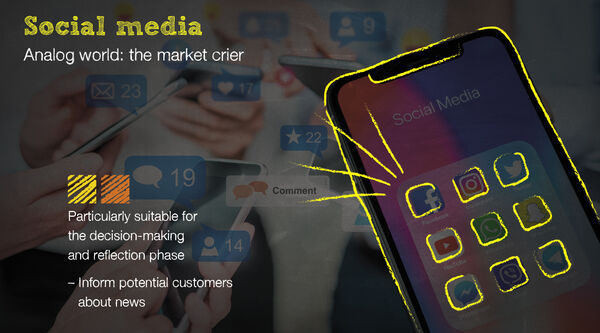
Social media – a flash in the pan
Social media determine a large part of our lives today. News, trends, opinions etc. spread extremely quickly around the world. But as quickly as a hype comes, it is usually over again. The most successful topics are those that are visually appealing or always offer something new. The potential is huge, but it is just as often forgotten that only very few campaigns are successful and that a lot of effort and hard work goes into perfect staging. Another important aspect is to appear authentic.
Reach and user numbers sound tempting. However, the question is whether the target group of these media matches the company's target group and other marketing measures. An important driver of social media is speed. It is precisely this fast pace that is actually the opposite of the green sector, which tends to work with consistent values. Areas of the green industry that are particularly creative, such as floristry or garden design, can certainly achieve a certain reach.
It is best to take a look at the various channels and look for market participants from the green sector and see how successful they are. In other words, how many followers they have and with what concept and effort the channel is operated.
We are often asked whether social media is worthwhile. A company can build up a fan base via social media, which can bring a certain degree of economic success. However, if the butget is invested in a good, informative website instead, the return on investment is usually much higher. Because: without a good web presence, further digital measures make little sense.
- Instagram: Is a very image-emphasised medium and therefore enjoys great popularity. It is essentially a digital glossy magazine that thrives on novelties and ideas and is well suited to publishing creative work, new products, etc. It is a rather fast-moving medium. A rather fast-moving medium.
- Facebook: Appeals more to an older target group. The number of regular users has fallen massively in recent years. Well suited for publishing news, events, projects, etc., as more detailed information can be provided.
- X (formerly Twitter): Is a short message service and is particularly suitable for spreading news. But how much regular and relevant news does your company have?
- Linked In: Functions as a network of people and companies with a strong B2B character. Can be interesting for recruiting new employees and marketing B2B services, for example.
- TikTok: Is on everyone's lips and is mainly used for sharing short videos. It appeals to a very young audience and can be successful if you speak their language.
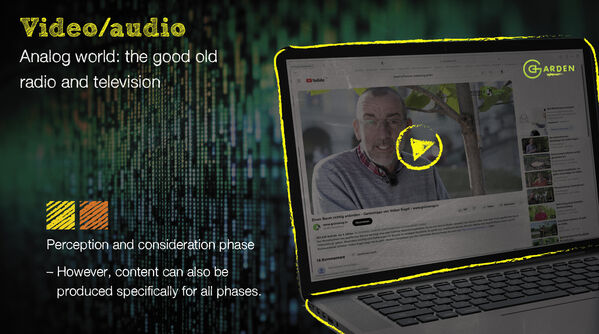
Streaming – an alternative
Digitalisation is also changing the way we consume music and films. YouTube, for example, offers a huge range of videos, films, entertainment and more. Advertising on this channel is controlled by Google's advertising network.
Music and film streaming is becoming increasingly popular. In addition to traditional streaming portals such as Spotify or Tidal, there are also more and more online offerings from radio and TV stations. Many offer the option of placing adverts. This can be interesting as the target group can be defined very precisely.
Conclusion
Henry Ford is said to have once said: "Half the marketing money is thrown out the window. Unfortunately, you don't know which half." This raises the question for all those who advertise: What's the point? At first glance, digital marketing offers the opportunity to capture and measure data well. However, it is more difficult to interpret and categorise these results correctly. This is because, as already mentioned elsewhere, customers are very heterogeneous. And the great danger is that a large part of the marketing budget is spent on analysing the results without the overall effect being greater. Your marketing money is best utilised when a common thread runs through all advertising measures and the target group can identify with it. This is the only way to acquire new customers and build a long-term customer base.
As mentioned at the beginning of this marketing series, marketing is like gardening: you have to sow first and then cultivate properly in order to be able to harvest at the end. That's why it's important to sow now so that you can reap in the future.


